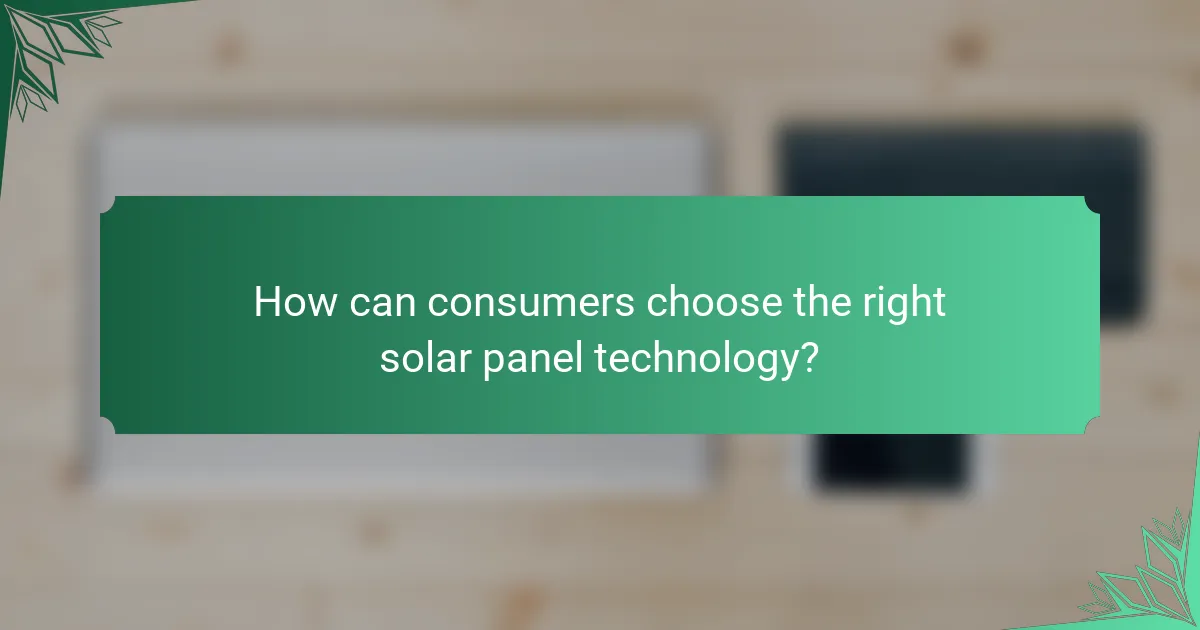
What is Solar Panel Technology?
Solar panel technology refers to the method of converting sunlight into electricity using photovoltaic cells. These cells are made primarily from silicon and generate direct current (DC) electricity when exposed to sunlight. An inverter then converts this DC electricity into alternating current (AC), which is usable for homes and businesses. Solar panels can be installed on rooftops or in solar farms. The efficiency of solar panels varies, typically ranging from 15% to over 22%. This technology contributes to renewable energy efforts and reduces reliance on fossil fuels. According to the International Energy Agency, solar power accounted for 3% of global electricity generation in 2019, demonstrating its growing significance.
How does solar panel technology work?
Solar panel technology converts sunlight into electricity. It primarily uses photovoltaic (PV) cells made of semiconductor materials like silicon. When sunlight hits these cells, it excites electrons, generating an electric current. This process is known as the photovoltaic effect. The electric current produced is direct current (DC). An inverter then converts DC into alternating current (AC) for use in homes and businesses. Solar panels typically consist of multiple PV cells connected together. The efficiency of these panels depends on factors like cell quality and sunlight exposure. In 2021, the average efficiency of commercially available solar panels ranged from 15% to 22%.
What are the key components of solar panels?
The key components of solar panels are photovoltaic cells, a backing material, a protective glass layer, and an aluminum frame. Photovoltaic cells convert sunlight into electricity. They are typically made from silicon. The backing material provides structural support and insulation. The protective glass layer shields the cells from environmental damage. The aluminum frame offers durability and facilitates mounting. Together, these components enable solar panels to effectively generate renewable energy.
How do solar panels convert sunlight into electricity?
Solar panels convert sunlight into electricity through a process called the photovoltaic effect. When sunlight hits the solar cells in the panels, it excites electrons, creating an electric current. This occurs in semiconductor materials, typically silicon, which are embedded in the solar cells. The excited electrons flow through the material, generating direct current (DC) electricity. An inverter then converts this DC electricity into alternating current (AC) electricity, which can be used in homes and businesses. According to the U.S. Department of Energy, solar panels can convert approximately 15-20% of the sunlight they receive into usable electricity.
What are the main types of solar panels?
The main types of solar panels are monocrystalline, polycrystalline, and thin-film panels. Monocrystalline panels are made from a single crystal structure. They are known for their high efficiency and longevity. Polycrystalline panels consist of multiple crystal structures. They are generally less expensive but also less efficient than monocrystalline panels. Thin-film panels are made by depositing photovoltaic material onto a substrate. They are lightweight and flexible but have lower efficiency. Each type has unique attributes that cater to different energy needs and installation scenarios.
What are monocrystalline solar panels and how do they differ?
Monocrystalline solar panels are photovoltaic devices made from a single crystal structure of silicon. They are known for their high efficiency and space-saving design. These panels typically have a uniform dark color and rounded edges. They differ from polycrystalline panels, which are made from multiple silicon crystals and have a speckled blue hue. Monocrystalline panels generally offer higher power output per square meter. They also perform better in low-light conditions compared to their polycrystalline counterparts. Additionally, monocrystalline panels have a longer lifespan, often exceeding 25 years. This durability is due to their solid structure, which reduces the likelihood of defects.
What are polycrystalline solar panels and their characteristics?
Polycrystalline solar panels are a type of photovoltaic solar panel made from multiple silicon crystals. These panels are characterized by their distinct blue hue and speckled appearance. They are produced by melting silicon fragments together, which leads to less energy efficiency compared to monocrystalline panels. The efficiency ratings for polycrystalline panels typically range from 15% to 20%.
Their manufacturing process is generally less energy-intensive, resulting in lower production costs. Polycrystalline panels tend to perform better in high temperatures than monocrystalline panels. However, they may occupy more space for the same energy output due to their lower efficiency. These panels have a lifespan of about 25 years, similar to other solar panel types.
What are thin-film solar panels and their applications?
Thin-film solar panels are a type of photovoltaic technology that uses a very thin layer of semiconductor material to convert sunlight into electricity. They are lighter and more flexible than traditional silicon-based solar panels. This flexibility allows for a variety of applications, including integration into building materials like windows and roofs. Thin-film panels can also be used in portable solar devices due to their lightweight nature. They perform better in low-light conditions compared to other types of solar panels. Additionally, they can be manufactured using less material, making them more environmentally friendly in some aspects. Their applications extend to large-scale solar farms, where they can be deployed on irregular surfaces.
What factors influence the efficiency of solar panels?
The efficiency of solar panels is influenced by several key factors. These factors include the type of solar cell technology used. Monocrystalline panels generally have higher efficiency rates compared to polycrystalline panels. Temperature also plays a significant role; higher temperatures can reduce efficiency. The angle and orientation of the panels affect how much sunlight they capture. Shading from trees or buildings can significantly decrease performance. Dust and dirt accumulation on the surface can block sunlight, reducing efficiency. Additionally, the quality of the inverter used impacts overall energy conversion. Lastly, the geographic location and climate conditions influence solar panel efficiency due to variations in sunlight exposure.
How is solar panel efficiency measured?
Solar panel efficiency is measured by the ratio of electrical output to sunlight input. This is expressed as a percentage. The measurement involves testing solar panels under standard conditions. These conditions typically include a temperature of 25 degrees Celsius and an irradiance of 1000 watts per square meter. The efficiency is calculated using the formula: Efficiency = (Power Output / Solar Input) x 100. Higher efficiency ratings indicate a better ability to convert sunlight into electricity. For example, a solar panel with 20% efficiency converts 20% of sunlight into usable energy. Efficiency ratings are crucial for comparing different solar panel technologies.
What are the typical efficiency ratings for different types of solar panels?
Typical efficiency ratings for different types of solar panels vary significantly. Monocrystalline solar panels typically achieve efficiencies between 15% and 22%. Polycrystalline panels generally have efficiencies ranging from 13% to 16%. Thin-film solar panels usually exhibit lower efficiencies, typically between 10% and 12%. These efficiency ratings are influenced by factors such as material quality and manufacturing processes. Monocrystalline panels are known for their high efficiency due to the purity of silicon used. Polycrystalline panels are less efficient because they contain multiple silicon crystals. Thin-film panels are less efficient but are often more flexible and lightweight.
How do environmental conditions affect solar panel efficiency?
Environmental conditions significantly affect solar panel efficiency. Factors such as temperature, sunlight intensity, and shading impact performance. Higher temperatures can reduce efficiency by causing semiconductor materials to lose voltage. For instance, studies show that solar panel output decreases by approximately 0.5% for every degree Celsius above 25°C. Sunlight intensity is crucial; panels perform best under direct sunlight. Cloudy or rainy conditions can lead to reduced energy production. Additionally, shading from trees or buildings can block sunlight, further decreasing efficiency. Dust and dirt accumulation on panels can also hinder performance by obstructing light. Regular cleaning and maintenance can mitigate these effects.

What is the lifespan of solar panels?
The lifespan of solar panels typically ranges from 25 to 30 years. Most manufacturers provide a warranty covering this period. During this time, solar panels maintain about 80% of their original efficiency. Factors such as climate, installation quality, and maintenance can influence longevity. Studies indicate that many panels continue to function beyond 30 years. Regular cleaning and inspections can help maximize their lifespan. Research shows that advancements in technology may further extend the operational life of solar panels.
How long do solar panels typically last?
Solar panels typically last between 25 to 30 years. Most manufacturers provide warranties that guarantee performance for this duration. Research indicates that solar panels can maintain around 80% of their efficiency after 25 years. Factors such as installation quality and environmental conditions can influence lifespan. Regular maintenance can also extend the life of solar panels.
What factors can affect the lifespan of solar panels?
The lifespan of solar panels can be affected by several factors. Environmental conditions play a significant role; extreme temperatures can lead to material degradation. UV radiation exposure can also weaken the panel materials over time. Additionally, physical damage from hail, debris, or improper installation can reduce their lifespan. The quality of the materials used in manufacturing is crucial; higher-quality panels typically last longer. Maintenance practices, such as regular cleaning and inspections, can help prolong their operational life. Finally, the technology type, such as monocrystalline or polycrystalline, can influence longevity, with some technologies generally offering longer lifespans.
How can proper maintenance extend the lifespan of solar panels?
Proper maintenance can significantly extend the lifespan of solar panels. Regular cleaning removes dirt and debris that can block sunlight. This ensures optimal energy production. Inspections help identify potential issues early. Detecting problems like loose connections or corrosion can prevent further damage. Routine maintenance can also include checking the inverter’s performance. A well-functioning inverter is crucial for energy conversion efficiency. Studies show that well-maintained solar panels can last 25 years or more. This contrasts with poorly maintained systems, which may fail prematurely.
What warranties are commonly offered for solar panels?
Common warranties for solar panels include performance warranties and product warranties. Performance warranties typically last 25 years. They guarantee a certain level of energy output over time. For example, many manufacturers promise at least 80% output after 25 years. Product warranties cover defects and workmanship. These warranties usually range from 10 to 25 years. They ensure that the panels will function properly without significant issues. Some manufacturers also offer extended warranties beyond the standard terms. This provides additional peace of mind for consumers.
What is covered under a typical solar panel warranty?
A typical solar panel warranty covers performance, defects, and workmanship. Performance warranties guarantee a certain level of energy output over a specified period. Defect warranties cover manufacturing defects and material issues. Workmanship warranties protect against installation errors. Most warranties last between 10 to 25 years. Performance warranties often promise at least 80% efficiency after 25 years. Defect and workmanship warranties generally last 5 to 10 years. These warranties ensure reliability and longevity of solar panels.
How do warranties differ among various manufacturers?
Warranties differ among various solar panel manufacturers primarily in duration and coverage. Some manufacturers offer 10 to 25-year warranties on product performance. Others might provide limited warranties that cover only specific defects. Additionally, the terms of labor coverage can vary significantly. Certain manufacturers include labor costs for installation and repairs, while others do not. The warranty conditions also differ, with some requiring regular maintenance checks. This variability can significantly impact the long-term ownership costs for solar panel systems. Understanding these differences is crucial for consumers when making purchasing decisions.

How can consumers choose the right solar panel technology?
Consumers can choose the right solar panel technology by assessing their energy needs and budget. They should consider the types of solar panels available, such as monocrystalline, polycrystalline, and thin-film. Each type has different efficiency ratings and costs. Monocrystalline panels offer high efficiency and space efficiency but are typically more expensive. Polycrystalline panels are less efficient but are more affordable. Thin-film panels are lightweight and flexible but generally have lower efficiency.
Additionally, consumers should evaluate the warranty and lifespan of the panels. Most solar panels come with a warranty of 25 years. Consumers should also check the efficiency ratings, which indicate how much sunlight is converted into usable energy. Higher efficiency ratings mean better performance, especially in limited space. Research suggests that monocrystalline panels often have efficiency ratings above 20%.
Finally, consumers should consider the installation and maintenance costs. Proper installation can maximize the performance of the solar panels. By taking these factors into account, consumers can make informed decisions about which solar panel technology best suits their needs.
What should consumers consider when selecting solar panels?
Consumers should consider efficiency ratings, cost, warranty, and brand reputation when selecting solar panels. Efficiency ratings indicate how well a panel converts sunlight into electricity. Higher efficiency panels produce more energy in less space. Cost includes both the purchase price and installation expenses. A longer warranty reflects the manufacturer’s confidence in their product’s durability. Brand reputation can influence reliability and customer service experiences. Additionally, consumers should assess the panel’s lifespan, typically around 25 years. Research shows that selecting high-efficiency panels can lead to greater long-term savings.
How do budget and cost factors influence solar panel choices?
Budget and cost factors significantly influence solar panel choices. Consumers often prioritize affordability when selecting solar panels. The initial purchase price is a critical consideration. Higher-quality panels typically come with a higher cost. However, cheaper panels may have lower efficiency and shorter lifespans. Long-term savings from energy bills can offset higher upfront costs. Additionally, available financing options can impact decisions. Government incentives may also play a role in reducing overall expenses. Ultimately, consumers balance upfront costs with potential long-term benefits.
What role do energy needs play in choosing solar panel types?
Energy needs significantly influence the selection of solar panel types. Different solar panels have varying efficiencies and power outputs. Higher energy demands may require more efficient panels, such as monocrystalline options. These panels convert up to 22% of sunlight into electricity. Conversely, polycrystalline panels are less efficient, often converting around 15-17% of sunlight.
The size of the solar installation also depends on energy consumption patterns. A household with high energy use may need a larger array of panels. This directly affects the type of panel chosen, as space and budget constraints play a role. Additionally, energy needs dictate the balance between cost and efficiency.
For example, a business with significant energy requirements may prioritize efficiency over initial costs. This approach maximizes long-term savings. Ultimately, understanding energy needs is crucial for selecting the appropriate solar panel type for optimal performance and cost-effectiveness.
What are some common troubleshooting tips for solar panels?
Check for shading on solar panels. Shading can significantly reduce energy production. Ensure that no trees, buildings, or debris block sunlight. Inspect the wiring for damage or loose connections. Damaged wires can hinder performance. Clean the solar panels regularly. Dirt and dust can accumulate and affect efficiency. Monitor the inverter’s performance. An error code may indicate issues needing attention. Check the system’s output regularly. Compare it to expected production levels. If output is low, further investigation is required. Contact a professional for complex issues. They can conduct thorough diagnostics and repairs.
How can users identify and resolve performance issues with solar panels?
Users can identify performance issues with solar panels by monitoring their energy output. Regularly check the energy production against expected values based on the system’s specifications. Inspect the panels for dirt, debris, or shading that can reduce efficiency. Additionally, users should examine the inverter for error codes or alerts.
To resolve these issues, clean the panels to remove any obstructions. Trim nearby trees or remove objects causing shade. If the inverter shows errors, consult the manual or contact a professional for repairs. Regular maintenance can help ensure optimal performance. According to the U.S. Department of Energy, proper maintenance can enhance energy production by up to 20%.
What maintenance practices can help optimize solar panel performance?
Regular cleaning of solar panels enhances their performance. Dust, dirt, and debris can obstruct sunlight. This obstruction reduces energy output significantly. Cleaning should be done every six months or as needed. Inspecting the panels for damage is crucial. Look for cracks or loose connections. Addressing these issues promptly prevents further degradation. Monitoring system performance is also essential. Use performance metrics to identify any drops in efficiency. Regular maintenance checks can prolong the lifespan of solar panels. Studies indicate that well-maintained panels can operate at up to 25% higher efficiency.
Solar panel technology is the process of converting sunlight into electricity through photovoltaic cells, primarily made from silicon. This article covers the various types of solar panels, including monocrystalline, polycrystalline, and thin-film, along with their efficiency ratings, which range from 10% to over 22%. It also discusses the lifespan of solar panels, typically between 25 to 30 years, and factors influencing their efficiency, such as temperature and shading. Additionally, the article addresses key components, maintenance practices, and warranty options available for solar panels, providing a comprehensive overview for consumers looking to understand solar technology better.